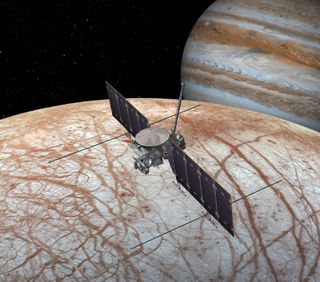
NASA should be allowed to consider launching its highly anticipated mission to Jupiter's ocean moon Europa on a private rocket, the space agency's Office of the Inspector General (OIG) has concluded.
The United States Congress has mandated that the Europa Clipper mission, which is scheduled to launch in 2023, ride atop NASA's huge Space Launch System (SLS) megarocket.
"However, because of developmental delays and, more significantly, NASA's plans to use the first three SLS rockets produced for its Artemis lunar program, an SLS will not be available until 2025 at the earliest," NASA Inspector General Paul Martin wrote in a letter to select lawmakers Tuesday (Aug. 27).
"Consequently, if completed on its projected schedule, the approximately $3 billion dollar Europa spacecraft (known as 'Europa Clipper') will need to be stored for at least 2 years at a cost of $3 to $5 million per month until an SLS becomes available," Martin added.
Related: Photos: Europa, Mysterious Icy Moon of Jupiter
"Given all of the foregoing factors, we urge Congress to consider removing the requirement that NASA launch the Europa Clipper on an SLS and allow the Agency to decide whether to use an SLS or a commercial vehicle based on cost, schedule, vehicle availability and impact on science requirements," he concluded in the letter, stressing that the OIG believes this issue "requires immediate action by Congress."
Commercial vehicles will be available for Clipper; Martin mentioned SpaceX's Falcon Heavy rocket and United Launch Alliance's Delta IV Heavy, both of which are already flying.
Get the Space.com Newsletter
Breaking space news, the latest updates on rocket launches, skywatching events and more!
Europa Clipper is designed to characterize the huge ocean of liquid water that sloshes beneath the moon's icy shell, assess Europa's ability to host life as we know it, scout out touchdown sites for a potential life-hunting lander mission and perform a number of other tasks. The probe will do this work during dozens of flybys of Europa, which it will make after reaching Jupiter orbit.
The SLS would allow Clipper to get to the gas giant much faster. The big NASA rocket will be powerful enough to launch the spacecraft directly to Jupiter, making the trip in a mere 2.4 years. The commercial alternatives would require a roundabout trajectory that takes advantage of planetary "gravity assists," resulting in a transit time of nearly 6 years, Martin wrote.
Still, NASA should be allowed to consider those alternatives, he stressed. The first three SLS rockets are already booked to aid NASA's Artemis program, which aims to land two astronauts near the lunar south pole by 2024 and establish a sustainable human presence on and around Earth's nearest neighbor by 2028.
Congress also directed NASA to launch the Europa lander aboard an SLS. Unlike Clipper, however, this mission is just a concept at the moment; it's not officially on the space agency's docket.
Tuesday's letter was a follow-up to a report into the Europa Clipper and Europa lander missions that the OIG released in May. That report determined that both projects face a variety of serious challenges on the way to the launchpad.
"Our audit found that, despite robust early-stage funding, NASA's aggressive development schedule, a stringent conflict of interest process during instrument selection, an insufficient evaluation of cost and schedule estimates, and technical workforce shortages have increased instrument integration challenges and development risks for the Clipper mission," John Schulz, an OIG management analyst, said in a video released with the May report.
- Europa’s Buried Ocean Could Rise to the Surface (Video)
- Europa Lander May Not Have to Dig Deep to Find Signs of Life
- 6 Most Likely Places for Alien Life in the Solar System
Mike Wall's book about the search for alien life, "Out There" (Grand Central Publishing, 2018; illustrated by Karl Tate), is out now. Follow him on Twitter @michaeldwall. Follow us on Twitter @Spacedotcom or Facebook.
Join our Space Forums to keep talking space on the latest missions, night sky and more! And if you have a news tip, correction or comment, let us know at: community@space.com.

Michael Wall is a Senior Space Writer with Space.com and joined the team in 2010. He primarily covers exoplanets, spaceflight and military space, but has been known to dabble in the space art beat. His book about the search for alien life, "Out There," was published on Nov. 13, 2018. Before becoming a science writer, Michael worked as a herpetologist and wildlife biologist. He has a Ph.D. in evolutionary biology from the University of Sydney, Australia, a bachelor's degree from the University of Arizona, and a graduate certificate in science writing from the University of California, Santa Cruz. To find out what his latest project is, you can follow Michael on Twitter.
